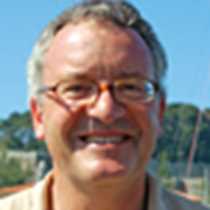Riga
We came alongside in the Daugava river in the early morning to a rather cold but mercifully dry day - after a recent exceptionally mild spell of weather - and disembarked early for our exploration of Riga, capital city of Latvia. Like its sister Baltic republics, Latvia is one of the smaller nations that make up today's European Union, a nation of some two and a half millions, the greater part of which inhabit the capital. Therein lies one of many Baltic paradoxes, for less than three-quarters of the nation's capital speaks the national language, Latvian, as their first language, there being a sizeable body of Russian speakers and the usual admixture of other nationalities that open borders and modern commerce tend to produce.
Latvian itself is a Baltic language akin to Lithuanian; the difference between those two countries being religious. Latvia has been Lutheran since the Reformation in the 1530s whereas Lithuania remained in the fold of Roman Catholicism. The great brick Cathedral church - in which we were treated to a fine organ recital - is markedly Lutheran in style - Martin Luther himself kept an eye on us during the concert from one of the stained glass windows. The cathedral, like those of the other Hanseatic cities we have visited, was modeled on the world's first brick cathedral, that of Lübeck, the hub city of the Hansa. This association of merchants, that dominated European trade from the eleventh to the fifteenth centuries, was culturally German and operated in the wake of the Teutonic Knights who had brought Christainaity - comparatively late - to this part of Europe.
Before our walking tour of the old city our bus had passed the large Orthodox church that serves the Russian community. We had been given a memorable tour of the new city that has one of the finest ensembles of art nouveau architecture in Europe, many of the buildings exquisitely restored. The real paradox of both the new and the old cities is that they are really neither Latvian nor Russian but Germanic in origin.
Later on we were treated to a Latvian folk dance performance by local school children, redolent of the Soviet era in its discipline and professionalism. It celebrated the pre-Christian nature themes that still hold sway beneath the surface here - we had seen a magnificent maypole in the main square earlier in the morning - and was performed in a Town Hall with stained glass windows inscribed in German with dedications to the mediaeval craft guilds. As I used to tell my students: "Enjoy the contradictions, they're the stuff of history." And nowhere more so that in the Baltic.
We came alongside in the Daugava river in the early morning to a rather cold but mercifully dry day - after a recent exceptionally mild spell of weather - and disembarked early for our exploration of Riga, capital city of Latvia. Like its sister Baltic republics, Latvia is one of the smaller nations that make up today's European Union, a nation of some two and a half millions, the greater part of which inhabit the capital. Therein lies one of many Baltic paradoxes, for less than three-quarters of the nation's capital speaks the national language, Latvian, as their first language, there being a sizeable body of Russian speakers and the usual admixture of other nationalities that open borders and modern commerce tend to produce.
Latvian itself is a Baltic language akin to Lithuanian; the difference between those two countries being religious. Latvia has been Lutheran since the Reformation in the 1530s whereas Lithuania remained in the fold of Roman Catholicism. The great brick Cathedral church - in which we were treated to a fine organ recital - is markedly Lutheran in style - Martin Luther himself kept an eye on us during the concert from one of the stained glass windows. The cathedral, like those of the other Hanseatic cities we have visited, was modeled on the world's first brick cathedral, that of Lübeck, the hub city of the Hansa. This association of merchants, that dominated European trade from the eleventh to the fifteenth centuries, was culturally German and operated in the wake of the Teutonic Knights who had brought Christainaity - comparatively late - to this part of Europe.
Before our walking tour of the old city our bus had passed the large Orthodox church that serves the Russian community. We had been given a memorable tour of the new city that has one of the finest ensembles of art nouveau architecture in Europe, many of the buildings exquisitely restored. The real paradox of both the new and the old cities is that they are really neither Latvian nor Russian but Germanic in origin.
Later on we were treated to a Latvian folk dance performance by local school children, redolent of the Soviet era in its discipline and professionalism. It celebrated the pre-Christian nature themes that still hold sway beneath the surface here - we had seen a magnificent maypole in the main square earlier in the morning - and was performed in a Town Hall with stained glass windows inscribed in German with dedications to the mediaeval craft guilds. As I used to tell my students: "Enjoy the contradictions, they're the stuff of history." And nowhere more so that in the Baltic.




